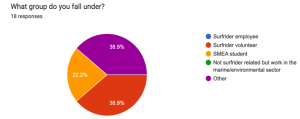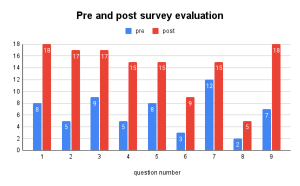Coastal states get a report card grade and recommendations based on their current coastal policies, in hopes of creating stronger coastal resilience in the face of climate change.
Written by: Andrea Richter-Sanchez M.M.A 2023 UW School of Marine and Environmental Affairs
Andrea worked with the Surfrider Foundation to assess 31 coastal states’ climate and coastal policies in order to produce the 2022 State of the Beach Report– a report that encourages policy makers to follow Surfrider’s recommendations and to empower citizens to work with policy makers to ensure their local communities are effectively planning in the face of climate change. This is a capstone in fulfillment of the UW PCC Graduate Certificate in Climate Science.
Non-profit organizations such as the Surfrider Foundation have been advocating for stronger sea level rise planning for years and they support nature-based solutions instead of hard coastal armoring. As stated on their website, “The Surfrider Foundation is dedicated to the protection and enjoyment of the world’s ocean, waves and beaches, for all people, through a powerful activist network.” Surfrider encourages states to adopt new laws and policies that ban coastal development in high-risk areas, restrict coastal armoring (seawalls, bulks, riprap, etc.), produce sediment analysis plans to decrease erosion, and create sea level rise adaptation and mitigation plans.
What did I do?
I worked with the Surfrider Foundation as their Coasts and Climate graduate fellow to conduct research and data collection to synthesize changes in coastal and climate laws and policies to begin the first draft of the 2022 State of the Beach Report (STOB). During this time, I conducted research on the 31 states and territories that are part of NOAA’s Coastal Zone Management Act (CZMA), in order to identify laws, policies, and management plans that demonstrate how each state scores across common metrics related to coastal policy. Surfrider’s rubric is divided into four categories: sediment management, coastal armoring, development, and sea level rise/climate hazards. Surfrider has been producing this report every year since 2016 to effectively communicate how each state can improve their coastal management laws and prepare for sea level rise. The report also serves as a tool to empower citizens to work with policy makers to ensure their local communities are effectively planning in the face of climate change.
Goals
1. Educate the audience about climate science related to sea level rise and erosion.
2. Compare and contrast coastal issues in Washington and Florida.
3. Show what current policies are being implemented in Washington and Florida.
4. Review policy recommendations from the State of the Beach report for Washington and Florida.
How did I do it?
I created a presentation that focused on Washington State, my current home and Florida, where I grew up, to compare and contrast issues and current policies in both states. I used the presentation to highlight Surfrider’s mission, their new living shorelines initiative, their recommendations, and positive coastal policies that were passed in 2022. The purpose of the capstone project is to practice climate science communication. I evaluated how well I performed this task by developing strategic survey questions for my audience. Pre and post surveys were given to audience members before and after the presentation in order to quantify how much they learned from my presentation.
How did it go?
After analyzing the pre and post surveys my results showed that the mean score went from 30.4% in the pre survey, to 75.3% in the post survey after the 45-minute presentation I held at the Seattle chapter Surfrider monthly meeting.


The graph illustrates how many people answered each question correctly in the pre and post surveys. There was a total of 18 audience members who completed the pre and post survey, therefore the maximum is set at 18. Both surveys had a total of nine multiple choice/check all that apply questions.
Questions from the survey
- What has a bigger impact on sea level rise?
- Which of these countries is facing the most intense effects due to sea level rise?
- Which of Surfrider’s initiatives are they focusing on this year?
- How many states have to follow the Coastal Zone Management Act (CZMA)?
- What does IPCC stand for?
- Why is shoreline armoring (aka hard structures) harmful for beaches? (Check all that apply)
- What living shoreline example is most used in South Florida?
- What is one benefit that Florida has over Washington state?
- What grade did Washington get on the State of the Beach report?
What were the STOB report’s final policy recommendations?
Washington recommendations
- Require all counties and municipalities to incorporate sea level rise into regional Shoreline Master Plans.
- The state legislature should bolster financial support to local communities to plan for sea level rise and other climate change impacts.
- Establish explicit regulations for beach dredge and fill projects to ensure coastal resource protection.
- Develop a coastal resiliency plan to comprehensively address the challenges of coastal erosion, sediment management and sea level rise.
- Explore mechanisms for managed retreat and infrastructure relocation.
Florida recommendations
- Ratify the Florida Beaches Habitat Conservation Plan to protect endangered coastal wildlife and prevent unnecessary development of Florida’s beaches and shorelines.
- Ensure proper and thoughtful implementation of new climate change laws and policies.
- Reduce reliance on and frequency of sand replenishment.
- Establish statewide restrictions on shoreline armoring and remove exemptions from the rule.
- Prohibit seawalls or coastal armoring for new developments.
- Update and implement inlet management plans so there is no net loss of sand (as most coastal erosion is caused by the state’s many engineered navigational inlets)
- Remove exemptions that allow any development seaward of the minimum setback line.
- Create new policies that incentivize the landward siting of new coastal development.
- Implement post-disaster redevelopment policies that prohibit building in the same vulnerable locations after storms.
- Expand and fully fund coastal land acquisition programs through direct purchase or conservation easements.
- Reform the state’s 25-year-old coastal development laws that allow development on the frontal dunes of critically eroding beaches.
Reflections
Overall, the work that I completed with my capstone project was successful. I was one of the main contributors to the 2022 State of the Beach report and the work allowed me to dive deep into coastal policy. This report is used by many non-profits, policy makers, and activist groups. It has also been mentioned on various news outlets to educate the public on current issues in their state. As for my presentation, I would have liked to focus more on the new bills that were introduced this year that helped increase Florida’s score. I originally decided to not spend too much time going over the bills because I was worried the audience would not be engaged by the material. However, I got some questions that focused on specific details relating to the bills I had mentioned. This showed me that audience members were more interested in diving deeper into the policy than expected.
I was happy with the turnout and with how engaged the audience members were. The audience asked great questions and were very thankful for the presentation. I had some attendees ask for the link to the report because they wanted to read Washington’s section. Others wanted to send the report to family members in other coastal states to let them know how their state scored and how it can improve. I am eager to see which states will follow these recommendations in future years and hope to see my home state of Florida improve their coastal and climate policies and laws to protect our coastal ecosystems and communities for the enjoyment of all people!
For further detail on the capstone project, feel free to reach out to Miriam Bertram (PCC Assistant Director) or myself for the capstone report.
Andrea is a recent graduate of the School of Marine and Environmental Affairs (SMEA) at the University of Washington. She completed this capstone project for the Graduate Certificate in Climate Science. Over the course of her masters, she has researched bull kelp’s carbon sequestration potential and its spatial distribution through Puget Sound relating to different environmental factors. She is working as an independent contractor for the Washington Department of Fish and Wildlife (WDFW) to complete part of her research assistantship that studied environmental justice issues related to marine toxins by using mussels as indicator species for bioaccumulation. She is identifying and working with the overburdened and marginalized communities affected by these issues.